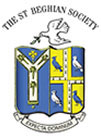|
 |
The Old St Beghian | |
| July 2017 | |||
J.B. (Tim) Nicholson (FN 34-37)
The following notice was kindly supplied by Tim’s nephew,
Nigel Nicholson (F 55-59):“Tim Nicholson had positive memories of his years at St Bees School. There was always a good atmosphere amongst the pupils and staff and he enjoyed his school days.
Academically he coped at St Bees with all subjects except one. In his first year he was put in the top Latin class,which was taught by the Headmaster. Unfortunately the Head was constantly called away from lessons, resulting in Tim failing the end of year examination and later giving up the subject altogether. He deeply regretted this decision as it excluded him from the opportunity of entering professions such as medicine, dentistry, law or veterinary science.
On the sports field Tim excelled. He was selected for the 1st XI and played two seasons for the 1st XV. He also played golf and squash and attended ATC training. During the school holidays he represented the U18 Durham County XV for two seasons in their matches against Northumberland and Yorkshire.
On leaving school he started to train as a mining engineer but this was interrupted when he volunteered for the WW2 war effort. He joined the Durham Light Infantry and because of his ATC training was commissioned as an officer. He was sent to train as the battalion sports officer and consequently missed being deployed to Dunkirk where his battalion suffered heavy losses. With the reorganised battalion he was involved with constructing defences along the South coast. He also served in Iceland before being trained to take part in the liberation of France.
He landed at Normandy on D Day plus seven as a commander of a troop of bren gun carriers with his regiment the Durham Light Infantry, which was part of the 49th (Polar Bear) Division under General Montgomery.
For the next seven weeks Tim and his men were engaged in continuous heavy action near Caen, which he survived despite heavy losses suffered by his battalion. However he was not so fortunate when some three weeks later he was severely wounded when his bren gun carrier was destroyed by an anti-tank mine.
He spent a year recovering from his injuries, and although he was unable to play rugby again, he was able to continue playing squash until he was 55 and golf until 90.
Tim married shortly before the end of the war, and after discharge from hospital, he returned to the mining industry in Co. Durham. He rose through the ranks of management until his early retirement from the National Coal Board in 1976 aged 56 as Deputy Chief Mining Engineer.
He was not ready to retire completely, so spent the next nine years as Bursar of Durham Cathedral. By this time his three children had married and moved south and so Tim and his wife left the North East and moved to Farnham to be near their family and grandchildren. He became heavily involved at the local golf club and about a year ago he took me for lunch there. It felt like following royalty the way the members revered and greeted Tim when he entered the clubhouse!
A few weeks before he died, the French government bestowed on him the Legion d’honneur medal for his contribution to the liberation of France; a fitting recognition of his service to his country and to France.
Throughout his long life Tim maintained a wonderful sense of humour and a sincere curiosity about other peoples’ experiences. He was respected by all who knew him and maintained a lifelong interest in St Bees School. The closure of the school deeply concerned him, but he died happy with the knowledge that the school would reopen.
Tim, as my uncle, was especially helpful to me when I started at St Bees in 1954. It was always with pride that I saw his name listed on the mid 30s 1st XV team engraved in gold on the honours board on Foundation.”
Home
The St Beghian Society
St Bees School,
St Bees, Cumbria, CA27 0DS.
Tel: (01946) 828093 Email: osb@stbeesschool.co.uk
Web: www.st-beghian-society.co.uk
![]()